As MegaFon and Nokia in Nizhny Novgorod 5G networks demonstrated
A few days ago I happened to visit Nizhny Novgorod at an international business summit where Megafon and Nokia demonstrated a prototype of a BS and a 5G standard receiver with a data transfer speed of almost 5 Gb / s:

In the photo on the right is a prototype of a new standard base station, on the left - prototype subscriber terminal.
You do not see that the subscriber terminal is the size of a base station and has an antenna the size of a computer case. By 2018 (and it is then that adoption of the 5G standard is expected), the subscriber part will dry out and, as usual, will fit into a small chip in your new phone.
Want to know more? Welcome to the cat: robotic manipulators, a few words about how data is transmitted, smart base stations, PTT with video and more.
To get started, let's get to know you. Very nice, base station:
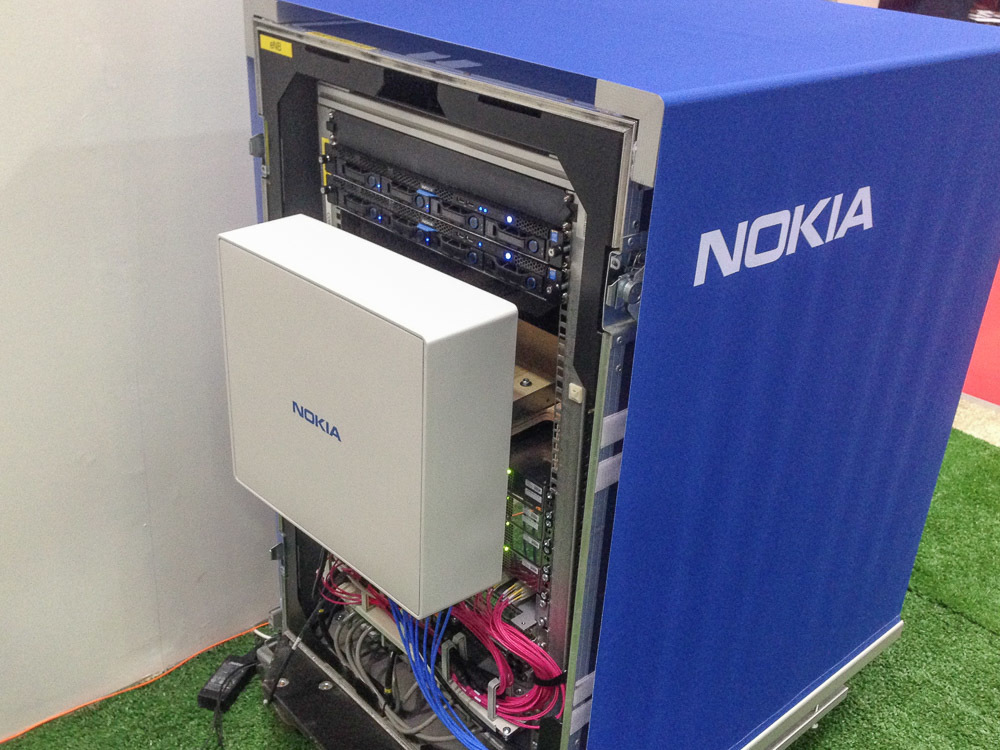
Very nice, subscriber terminal:
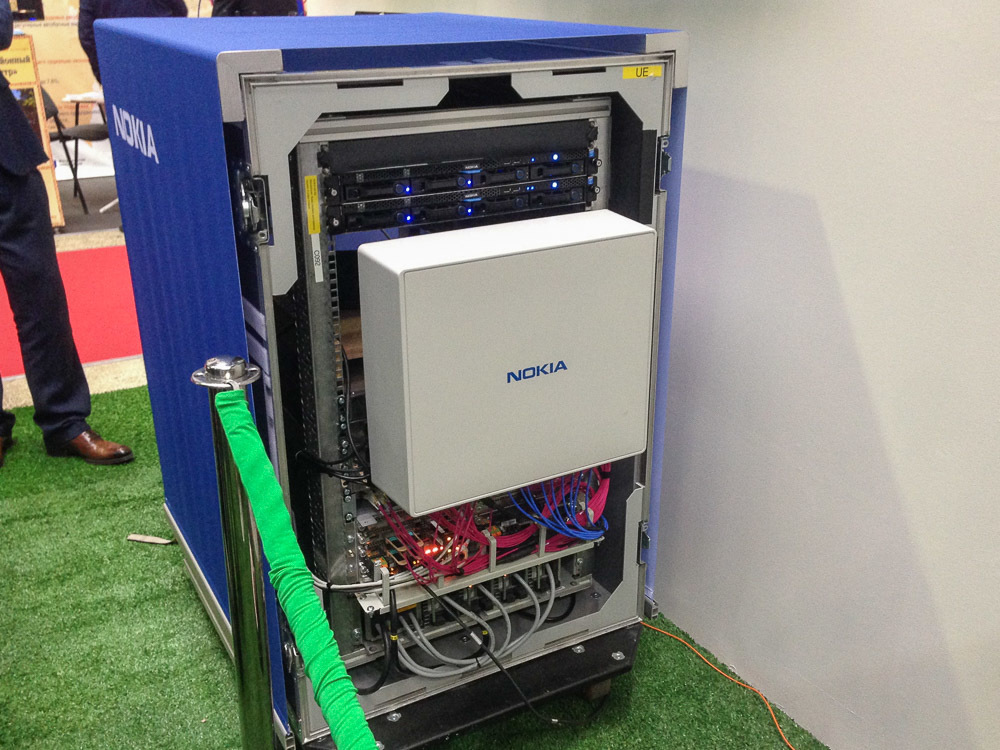
Between them - a five gigabit radio channel:

Well, actually a little less:
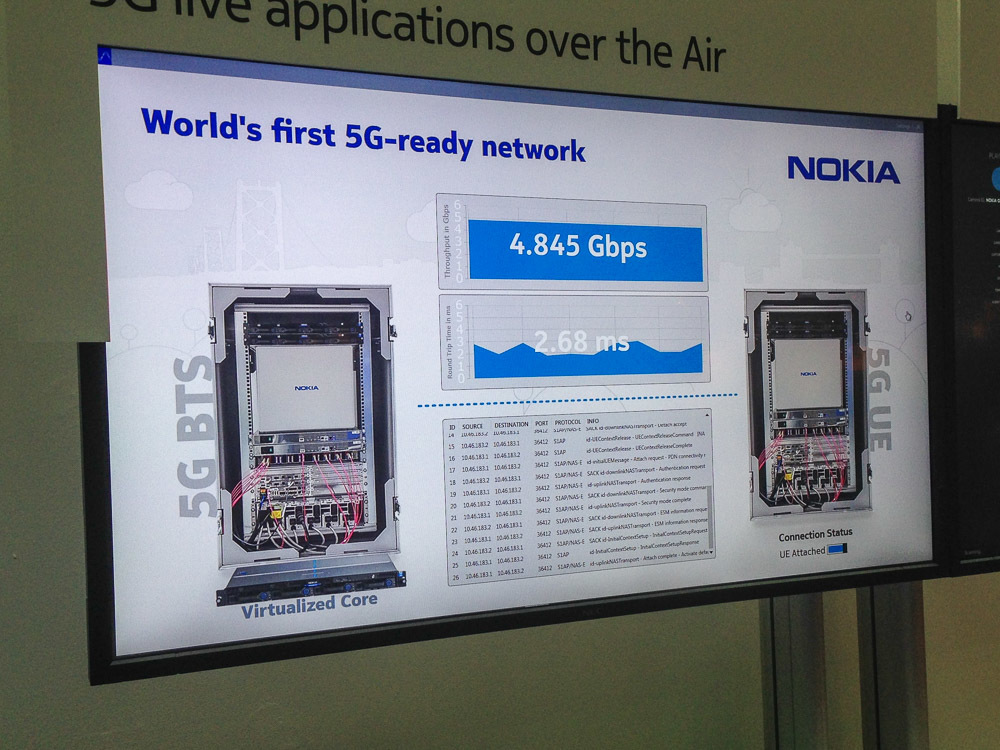
Five gigabits is enough to overtake 8 video streams with a resolution of 7680 × 4320 in real time, plus 3 FullHD video streams and there will still be room for little traffic with minimal delays.

This is achieved by the aggregation of two cells along with MIMO 8x8. Didn’t understand anything? So do I. Therefore, I had to find a person who understands this, and torture him with a voice recorder for half an hour.
Aggregation of two hundred - this means that the data is transmitted not on one frequency, but on two. A honeycomb is a specific carrier supported by a base station. One base station can lift several hundred at once.
Here, for example, the signal spectrum is visible:
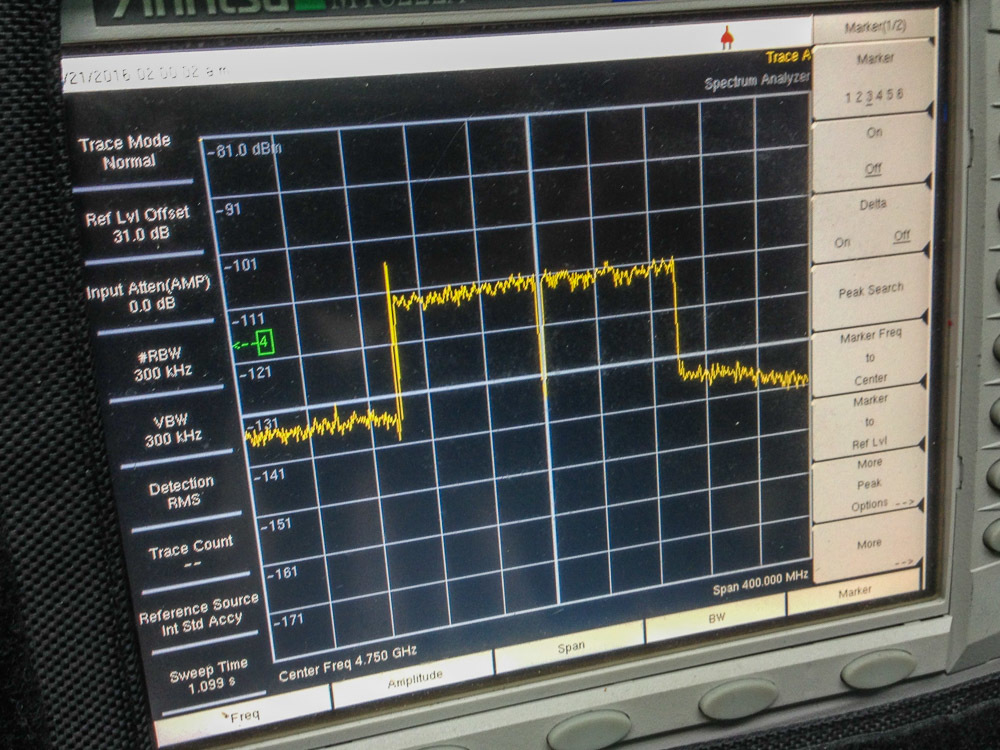
On both sides of the central “dip”, there are just two carriers, each 100 MHz wide. For example, in 3G networks, the carrier width is at 5 MHz, and in LTE at 20 MHz.
MIMO is such a technology for cramming into the same band several times more data due to orthogonal codes. In this case, 8x8 is the transmission at the same frequency of 8 different signals for reception and transmission.
Articles about OFDM and MIMO are on a habr, for example here and here .
MIMO is used both to increase speed (as in the case of the current 5G prototype), and to improve communication when the same data is transmitted on different channels. For example, the current 4G (LTE) communication standards support MIMO up to 4x4, although in practice phones and modems do not use more than 2x4.
The 4.5 GHz band has less penetrating power compared to 2 GHz in 3G and 2G, so base stations will have to be installed more often. However, there are pluses in this too - the more stations, the greater the capacity they have, and the greater the number of subscribers they can handle, so there should be less situations “a lot of people in one place and nothing works”.

It is important to understand that the current characteristics are not the ultimate communications standard, but just an attempt by Nokia engineers to implement a 5G network according to their own understanding. The final standard is still being developed and approved by 3GPP , and when it is finally fixed in 2018, it will probably be quite different from the current implementation. However, these experiments will also not be in vain - they will be taken into account when discussing and developing the standard, since real tests are difficult to replace only with calculations.
In addition, the final standard will support the Internet of things - many small sensors and devices (we leave out the question whether there is a need to connect all these sensors to the cellular network and pay operators for the traffic, instead of creating their own network).
So, how are we shown speed and low latency?
For example, here is a platform on which a ball freely rolls, supported by three manipulators:

They are controlled by a computer that receives an image from a camera mounted above the platform. When he sees the ball, he forms commands for the movement of the manipulators so that the ball rolls exactly to the center of the platform. How does a machine vision task relate to 5G networks?
And the thing is that video data and commands to the manipulators are transmitted through the radio bridge “base station - subscriber terminal”. Accordingly, there is a certain delay between sending data from the camera and receiving commands by the manipulators, which is caused by image processing and data transfer rate (more precisely, not even speed, but delay).
If we artificially introduce a delay of about 100ms into this channel, simulating 4G communication, then we observe the following picture:

Without proper optimization at the time of receiving commands to change the platform position, the ball position is already irrelevant - it managed to roll away from the calculated trajectory, so the command that reached the manipulator only makes it worse by forcing the ball to move in the wrong direction. Thus, a delay of 100ms, weakly felt by a person, already sufficiently affects even such a simple system as a ball rolling on a board.
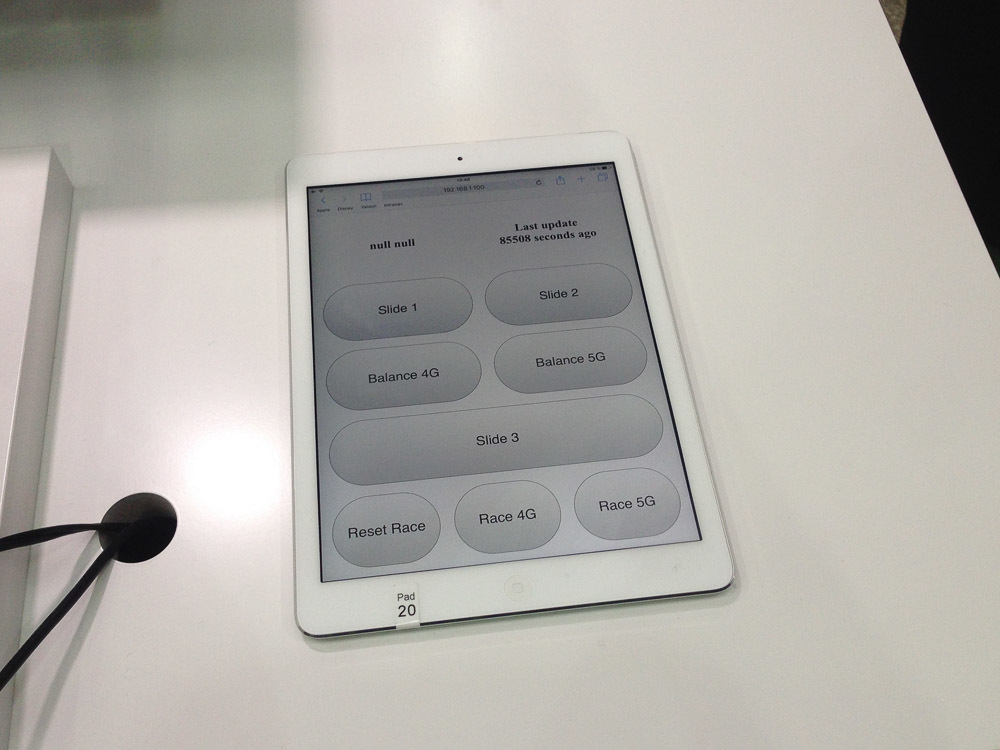
But it’s worth removing the introduced delay by switching the parameters of the data channel to the real parameters of 5G technology (5ms when the channel is fully loaded, half the load without loading, the delay includes a round-trip signal), as everything magically returns to normal: in a few seconds, the control program stops the ball in the center of the platform.

Virtual reality also applies to 5G networks: the data on the position of the glasses and the transfer of the picture back to the glasses are also transmitted through the 5G network, which shows low delays in video transmission, invisible to the human eye.

Of course, in real life it would never occur to anyone to make virtual reality glasses with video transmission over a cellular network, this is just an example showing the capabilities of the technology. I put on my glasses and turned my head with pleasure, flying past Moscow City. I confirm that there are no delays. The pixels in the glasses are noticeable, but there is no delay.
Another stand is dedicated to the so-called “smart base stations” - Mobile Edge Computing technology. This is a technology that allows you to install servers in the base stations that are engaged in some tasks "on the spot." This ensures a low delay (just those same 5ms, because everyone understands that in real use, the signal transit time to third-party servers and back will be added to these 5ms), and saving channels from the BS to the provider.
For example, here on one of these servers a video motion detector works:

You go inside the guarded perimeter, it starts to squeak:

I have not yet figured out where such technology could be useful, but let it be.
The last exposition is secure communicators with operational audio and video communications based on the Missian Critical Push-To-Tallk solution:
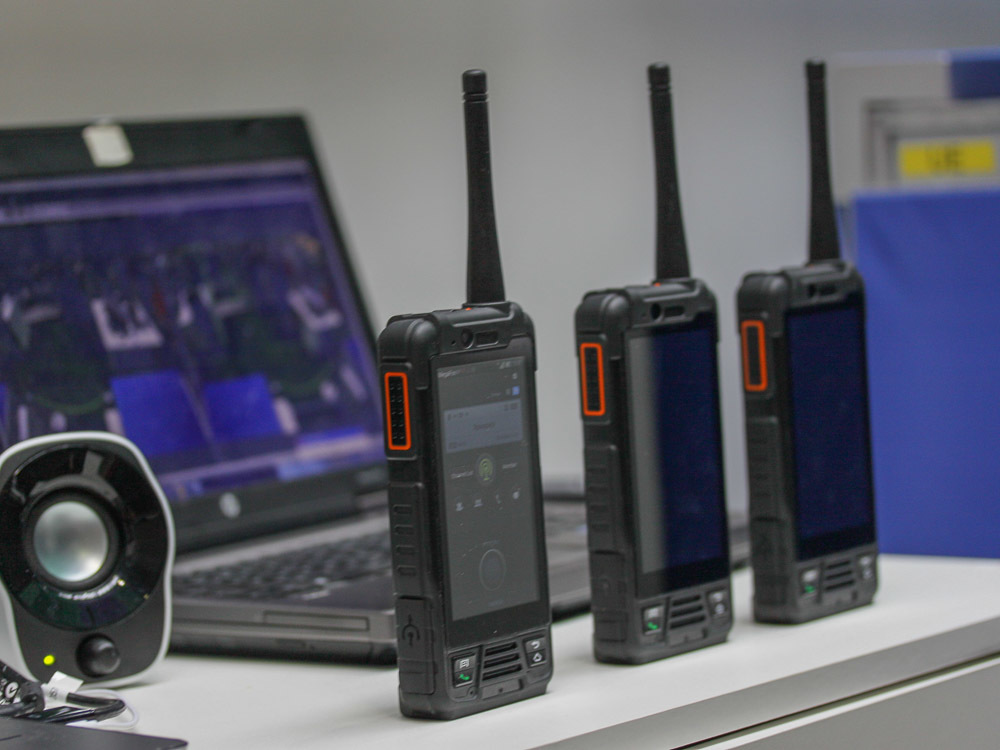
If anyone does not know, PTT is an attempt to make a walkie-talkie out of cell phones. You don’t need to dial the number, pressed the button, and all members of your group (which is no longer limited by the radio signal power of the radio) hear you. In addition to audio, there is also a video:

- Petrovich, look at me the wire is torn off. What colors to combine?
In addition, the pluses are that you can record all the conversations and output transfers to the dispatcher on a computer.
At this point we finish the inspection of interesting exhibits, eat a cookie:
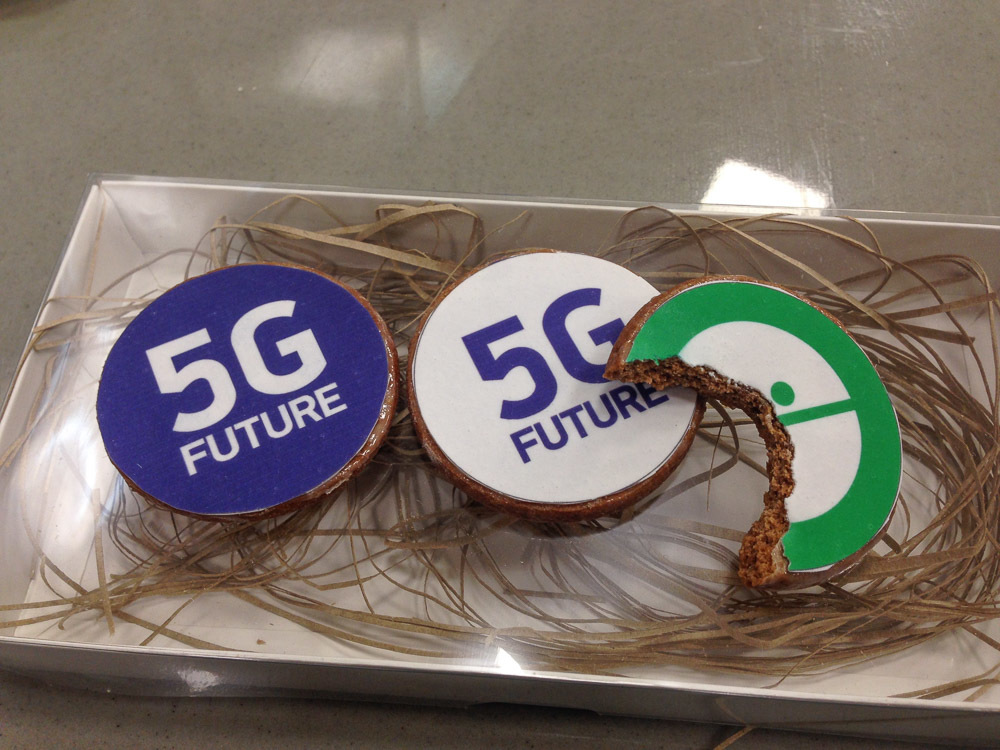
And we go back to Moscow, to our native 4G.


In the photo on the right is a prototype of a new standard base station, on the left - prototype subscriber terminal.
You do not see that the subscriber terminal is the size of a base station and has an antenna the size of a computer case. By 2018 (and it is then that adoption of the 5G standard is expected), the subscriber part will dry out and, as usual, will fit into a small chip in your new phone.
Want to know more? Welcome to the cat: robotic manipulators, a few words about how data is transmitted, smart base stations, PTT with video and more.
To get started, let's get to know you. Very nice, base station:

Very nice, subscriber terminal:

Between them - a five gigabit radio channel:

Well, actually a little less:

Five gigabits is enough to overtake 8 video streams with a resolution of 7680 × 4320 in real time, plus 3 FullHD video streams and there will still be room for little traffic with minimal delays.

This is achieved by the aggregation of two cells along with MIMO 8x8. Didn’t understand anything? So do I. Therefore, I had to find a person who understands this, and torture him with a voice recorder for half an hour.
Aggregation of two hundred - this means that the data is transmitted not on one frequency, but on two. A honeycomb is a specific carrier supported by a base station. One base station can lift several hundred at once.
Here, for example, the signal spectrum is visible:

On both sides of the central “dip”, there are just two carriers, each 100 MHz wide. For example, in 3G networks, the carrier width is at 5 MHz, and in LTE at 20 MHz.
MIMO is such a technology for cramming into the same band several times more data due to orthogonal codes. In this case, 8x8 is the transmission at the same frequency of 8 different signals for reception and transmission.
Articles about OFDM and MIMO are on a habr, for example here and here .
MIMO is used both to increase speed (as in the case of the current 5G prototype), and to improve communication when the same data is transmitted on different channels. For example, the current 4G (LTE) communication standards support MIMO up to 4x4, although in practice phones and modems do not use more than 2x4.
The 4.5 GHz band has less penetrating power compared to 2 GHz in 3G and 2G, so base stations will have to be installed more often. However, there are pluses in this too - the more stations, the greater the capacity they have, and the greater the number of subscribers they can handle, so there should be less situations “a lot of people in one place and nothing works”.

It is important to understand that the current characteristics are not the ultimate communications standard, but just an attempt by Nokia engineers to implement a 5G network according to their own understanding. The final standard is still being developed and approved by 3GPP , and when it is finally fixed in 2018, it will probably be quite different from the current implementation. However, these experiments will also not be in vain - they will be taken into account when discussing and developing the standard, since real tests are difficult to replace only with calculations.
In addition, the final standard will support the Internet of things - many small sensors and devices (we leave out the question whether there is a need to connect all these sensors to the cellular network and pay operators for the traffic, instead of creating their own network).
So, how are we shown speed and low latency?
For example, here is a platform on which a ball freely rolls, supported by three manipulators:

They are controlled by a computer that receives an image from a camera mounted above the platform. When he sees the ball, he forms commands for the movement of the manipulators so that the ball rolls exactly to the center of the platform. How does a machine vision task relate to 5G networks?
And the thing is that video data and commands to the manipulators are transmitted through the radio bridge “base station - subscriber terminal”. Accordingly, there is a certain delay between sending data from the camera and receiving commands by the manipulators, which is caused by image processing and data transfer rate (more precisely, not even speed, but delay).
If we artificially introduce a delay of about 100ms into this channel, simulating 4G communication, then we observe the following picture:

Without proper optimization at the time of receiving commands to change the platform position, the ball position is already irrelevant - it managed to roll away from the calculated trajectory, so the command that reached the manipulator only makes it worse by forcing the ball to move in the wrong direction. Thus, a delay of 100ms, weakly felt by a person, already sufficiently affects even such a simple system as a ball rolling on a board.

But it’s worth removing the introduced delay by switching the parameters of the data channel to the real parameters of 5G technology (5ms when the channel is fully loaded, half the load without loading, the delay includes a round-trip signal), as everything magically returns to normal: in a few seconds, the control program stops the ball in the center of the platform.

Virtual reality also applies to 5G networks: the data on the position of the glasses and the transfer of the picture back to the glasses are also transmitted through the 5G network, which shows low delays in video transmission, invisible to the human eye.

Of course, in real life it would never occur to anyone to make virtual reality glasses with video transmission over a cellular network, this is just an example showing the capabilities of the technology. I put on my glasses and turned my head with pleasure, flying past Moscow City. I confirm that there are no delays. The pixels in the glasses are noticeable, but there is no delay.
Another stand is dedicated to the so-called “smart base stations” - Mobile Edge Computing technology. This is a technology that allows you to install servers in the base stations that are engaged in some tasks "on the spot." This ensures a low delay (just those same 5ms, because everyone understands that in real use, the signal transit time to third-party servers and back will be added to these 5ms), and saving channels from the BS to the provider.
For example, here on one of these servers a video motion detector works:

You go inside the guarded perimeter, it starts to squeak:

I have not yet figured out where such technology could be useful, but let it be.
The last exposition is secure communicators with operational audio and video communications based on the Missian Critical Push-To-Tallk solution:

If anyone does not know, PTT is an attempt to make a walkie-talkie out of cell phones. You don’t need to dial the number, pressed the button, and all members of your group (which is no longer limited by the radio signal power of the radio) hear you. In addition to audio, there is also a video:

- Petrovich, look at me the wire is torn off. What colors to combine?
In addition, the pluses are that you can record all the conversations and output transfers to the dispatcher on a computer.
At this point we finish the inspection of interesting exhibits, eat a cookie:

And we go back to Moscow, to our native 4G.

